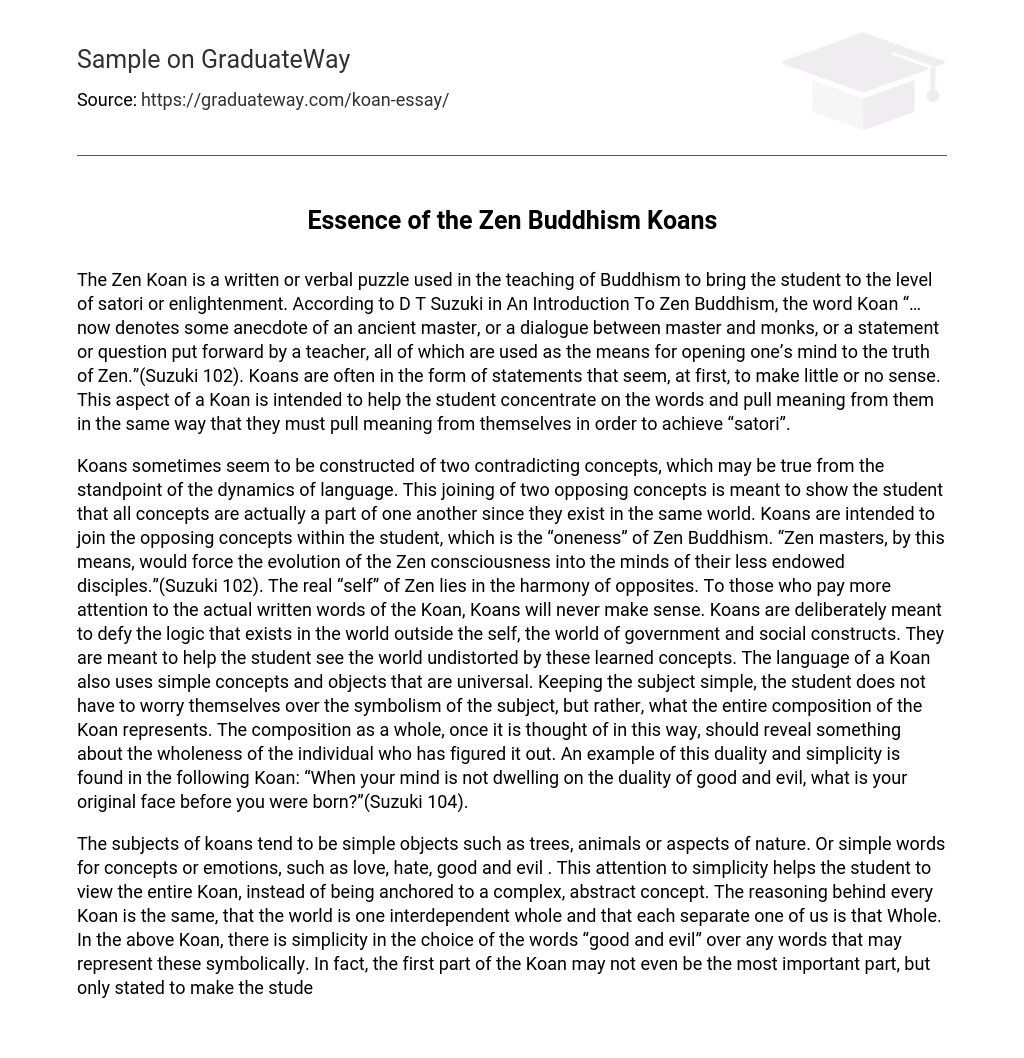The Zen Koan is a puzzle, whether written or verbal, that is utilized in Buddhism to guide the student towards satori or enlightenment. As stated by D T Suzuki in the book “An Introduction To Zen Buddhism,” the term Koan now encompasses various elements such as anecdotes of ancient masters, dialogues between masters and monks, or statements and questions posed by teachers. All these components serve as tools for opening one’s mind to the truth of Zen (Suzuki 102). Koans often take the form of seemingly nonsensical statements, with the intention of encouraging students to focus on the words and extract meaning from them. This mirrors the process of extracting meaning from oneself, which is necessary to attain “satori”.
Koans may appear to consist of conflicting concepts, but this is deliberate in order to demonstrate that all concepts are interconnected within the same world. The purpose of Koans is to unite these opposing concepts within the student, reflecting the unity of Zen Buddhism. By using this technique, Zen masters aimed to facilitate the development of Zen consciousness in their disciples. The essence of Zen lies in the harmonious coexistence of opposites. Those who focus solely on the literal words of a Koan will never grasp its meaning. Koans are designed to challenge the logical framework of external systems such as government and social constructs, enabling students to perceive the world without these preconceptions. The language used in a Koan employs simple and universally understood concepts and objects. By keeping the subject matter uncomplicated, students can focus on comprehending the overall message conveyed by the Koan. When viewed in this way, the composition as a whole should reveal something profound about the holistic nature of the individual who solves it.Suzuki (104) provides an example of the duality and simplicity through a Koan. The Koan asks, “What is your original face before you were born?” It highlights how the mind should not focus on the dualities of good and evil.
Koans typically focus on simple objects such as trees, animals, or aspects of nature, as well as simple words for concepts or emotions like love, hate, good and evil. This emphasis on simplicity allows the student to see the entire Koan, rather than being fixated on complex, abstract ideas. The underlying reasoning behind every Koan is that the world is a unified whole and each individual is a part of that Whole. In this particular Koan, the choice of the words “good and evil” represents simplicity instead of symbolic representation. The initial part of the Koan may not actually be the most vital aspect; it serves to help the student recognize their preoccupation with the duality of the external world. The conflicts in the external world have been diverting the student from realizing the purity of their own existence “before you were born.”
The famous Koan that poses the question “What is the sound of one hand clapping?” presents an intriguing challenge when approached with the logical thinking learned from society. According to conventional wisdom, there is no sound produced by a single hand. As stated, “Ordinarily, a sound is heard only when two hands are clapping, and in that sense no sound can come from one hand alone…” However, this Koan aims to disrupt our everyday understanding of reality, which is influenced by scientific and logical principles (Suzuki 105). The contradiction lies in the accepted notion of what is considered logical. This Koan challenges our established knowledge of how the world is supposed to function. As Suzuki explains, “The Koans, therefore, as we have seen, are generally such as to shut up all possible avenues to rationalization” (Suzuki 108).
According to Zen Buddhism, the Koan is an inherently irrational concept that challenges the superficial knowledge possessed by students and encourages them to seek inner knowledge. This suggests that all humans have an innate understanding that acknowledges the interconnectedness of all things. The purpose of the Koan is to assist students in bringing this understanding to the forefront and living with a sense of internal awareness. It teaches students to remain undistracted by external events and to view all occurrences as both internal and external, recognizing their interdependence.





